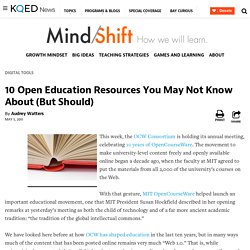

10 Open Education Resources You May Not Know About (But Should) This week, the OCW Consortium is holding its annual meeting, celebrating 10 years of OpenCourseWare.

The movement to make university-level content freely and openly available online began a decade ago, when the faculty at MIT agreed to put the materials from all 2,000 of the university’s courses on the Web. With that gesture, MIT OpenCourseWare helped launch an important educational movement, one that MIT President Susan Hockfield described in her opening remarks at yesterday’s meeting as both the child of technology and of a far more ancient academic tradition: “the tradition of the global intellectual commons.” We have looked here before at how OCW has shaped education in the last ten years, but in many ways much of the content that has been posted online remains very much “Web 1.0.” But as open educational resources and OCW increase in popularity and usage, there are a number of new resources out there that do offer just that. Richard Phillips Feynman - The Last Journey Of A Genius[1988] Selecting Appropriate Technology for Online Learning « My MA in Learning and Technology Blog.
Analysis of the SECTIONS Model in the 21st Century MA Learning and Technology, LRNT 503 – Royal Roads University – Unit 3 Group Project- Brian Bailey, Susan Fisher, Rose Murray & Ingrid Wagemans 10/17/2010 – Evaluated by Elizabeth Wellburn, Royal Roads University – Graded A+ In their book, Effective Teaching with Technology in Higher Education, Bates and Poole (2003) described a model they designed which could be used for selecting and using technology for distance education programs.
The model they designed was called SECTIONS which stands for Students, Ease of use and reliability, Costs, Teaching, Interactivity, Organizational issues, Novelty, and Speed. What follows is an analysis of these elements as we move into the 21st century and how to reframe the questions Bates and Poole originally asked, in light of Web 2.0 learning environments.
The first element of the Bates and Poole’s SECTIONS model considers students. A cautionary note around Web 2.0 is privacy. References Like this: 150 Free Textbooks: A Meta Collection. Free textbooks (aka open textbooks) written by knowledgable scholars are a relatively new phenomenon.

Below, find a meta list of 200 Free Textbooks, and check back often for new additions. Also see our online collection, 1,700 Free Online Courses from Top Universities. Art History. Calendário Escolar para o ano lectivo 2011-2012. Tips and Tricks. BuddyPress.org. Sixent. Every organization is different which is why Sixent was designed with the capability to be customized to fit around your business need.

Selectively activate functionality to different user groups, create any number of fully customizable public and private groups and group pages that securely co-exist in the same site, introduce new members to the most appropriate groups and key people and be assured that confidential information is never inadvertently shared with the wrong audience. What's more, every user can customize their own Dashboard, personal data and how they connect and share with other users so they have confidence in the system too.
Sixent provides an unrivalled flexibility to build dynamic and content-rich pages with custom layout, styles, graphics, content organization and data sources. That means you can provide the right content in the right place for people to naturally discover, share and use. 25 Google+ Tips to Enhance Your Google Plus Experience. Google has finally rolled out Google+ which is not yet another service like Google Wave and Buzz, but is an amazing and power packed social networking website which is deemed to rise very high and compete with today’s biggies ‘Facebook and Twitter’.

I tried out Google+ after getting an invite and found it really interesting, may it be its simple and cool design or the variety of features it offers. One has to accept that Google has done some really good and hard work in bringing out Google+. After all, it was their long time wish to have a Google Social Network that can dominate over the web. # Here are some useful Google+ Tips shared by Matt Cutts and users who responded to Matt’s post at Google+. All these tips are handy and let you experience the actual power of Google+ (PLUS). 1. 2. 3. (*)bold(*): Add * before and after the message. (_)italics(_): Add _ before and after the message. (-)strike-through(-): Add - before and after the message. 4. 5. 6. Replies and more for Google+ ERTE/PTE. The Educator's PLN - The personal learning network for educators. How technology can be used to improve education – a matter of opinion « Online Education News.
Education in 2025.mov